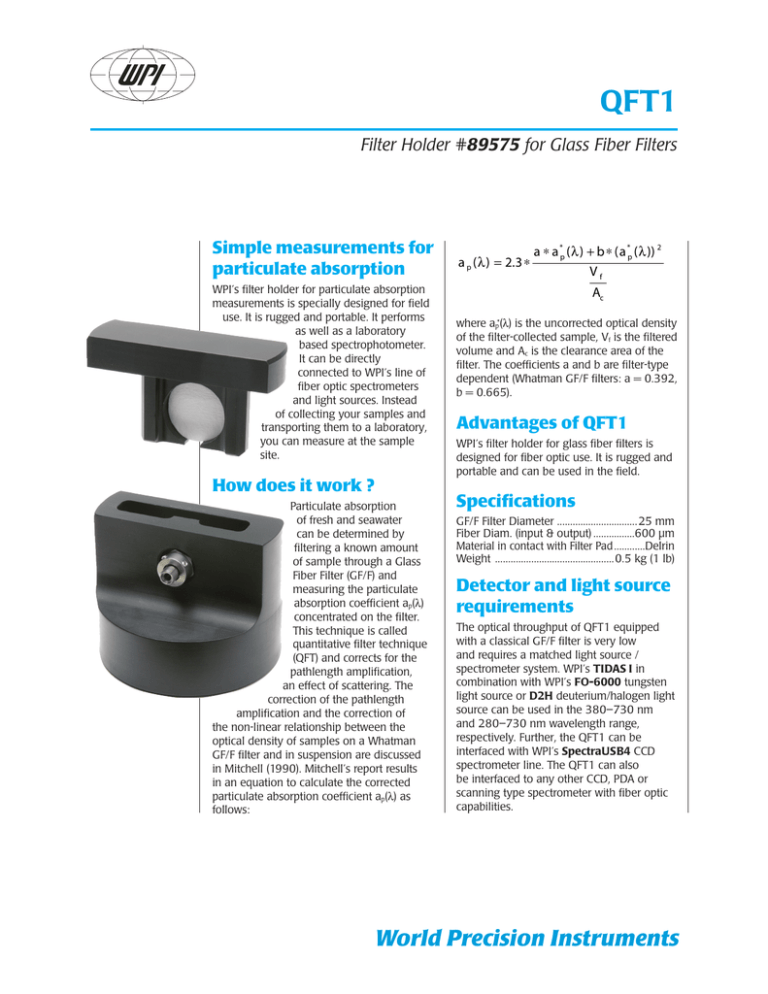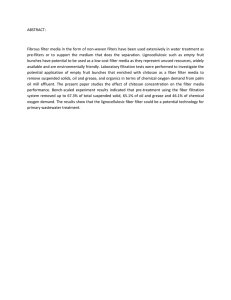World Precision Instruments - WPI
advertisement

QFT1 Filter Holder #89575 for Glass Fiber Filters Simple measurements for particulate absorption WPI’s filter holder for particulate absorption measurements is specially designed for field use. It is rugged and portable. It performs as well as a laboratory based spectrophotometer. It can be directly connected to WPI’s line of fiber optic spectrometers and light sources. Instead of collecting your samples and transporting them to a laboratory, you can measure at the sample site. How does it work ? Particulate absorption of fresh and seawater can be determined by filtering a known amount of sample through a Glass Fiber Filter (GF/F) and measuring the particulate absorption coefficient ap(λ) concentrated on the filter. This technique is called quantitative filter technique (QFT) and corrects for the pathlength amplification, an effect of scattering. The correction of the pathlength amplification and the correction of the non-linear relationship between the optical density of samples on a Whatman GF/F filter and in suspension are discussed in Mitchell (1990). Mitchell’s report results in an equation to calculate the corrected particulate absorption coefficient ap(λ) as follows: a ∗ a *p ( λ ) + b ∗ ( a *p ( λ )) 2 a p ( λ ) = 2. 3 ∗ Vf Ac where ap*(λ) is the uncorrected optical density of the filter-collected sample, Vf is the filtered volume and Ac is the clearance area of the filter. The coefficients a and b are filter-type dependent (Whatman GF/F filters: a = 0.392, b = 0.665). Advantages of QFT1 WPI’s filter holder for glass fiber filters is designed for fiber optic use. It is rugged and portable and can be used in the field. Specifications GF/F Filter Diameter ...............................25 mm Fiber Diam. (input & output).................600 μm Material in contact with Filter Pad.............Delrin Weight . .............................................0.5 kg (1 lb) Detector and light source requirements The optical throughput of QFT1 equipped with a classical GF/F filter is very low and requires a matched light source / spectrometer system. WPI’s TIDAS I in combination with WPI’s FO-6000 tungsten light source or D2H deuterium/halogen light source can be used in the 380–730 nm and 280–730 nm wavelength range, respectively. Further, the QFT1 can be interfaced with WPI’s SpectraUSB4 CCD spectrometer line. The QFT1 can also be interfaced to any other CCD, PDA or scanning type spectrometer with fiber optic capabilities. World Precision Instruments QFT1 Performance To test the performance of the QFT1, seawater samples were collected locally and filtered through a GF/F filter pad. The particulate absorption was measured with the QFT1 and for comparison with a Lambda 35 UV/VIS spectrometer equipped with a RSA-PE-20 integrating sphere attachment. The measured particulate absorbance spectra overlay well for a number of samples. Linearity was tested with five graduated fresh water sample concentrations. Collected pond water was diluted with CDOM in five different dilutions. Baseline absorbance of five new filter pads A linear relationship between sample concentration and absorbance was found at three chosen wavelengths (425 nm, 575 nm, 675 nm). A significant advantage of the filter holder is its large beam diameter of 5 mm, resulting in “averaging out” of larger non-organic particles frequently found on the filter pad when using natural samples. The removable filter fixture allows simple filter alternation and cleaning. Based on the reliability and repeatability of the data, it was concluded, that the filter holder can serve as an adequate reference method. Fiber optic connections The QFT1 has two fiber optic SMA mating sleeves for light input and output. Two fiber optic cables with preferably 600 μm core diameter are necessary to connect the QFT1 to a light source and a detector. References Mitchell, B. G., “Algorithms for Determining the Absorption Coefficient of Aquatic Particles Using the Quantitative Filter Technique (QFT)”, SPIE Vol. 1302 Ocean Optics X (1990), 137-148. Belz, Mathias; Larsen, Kai; Klein, Karl-Friedrich; “Fiber optic sample cells for polychromatic detection of dissolved and particulate matter in natural waters”, SPIE Vol. 6377 (2006). 0.4 Sample 1, Int. Sphere 0.35 Sample 2, Int. Sphere 0.3 Sample 1, Filter Pad Holder 0.25 Sample 2, Filter Pad Holder 0.2 0.15 Absorbance [AU] 0.1 0.05 0 375 475 575 675 w ave le n gth [n m ] Particulate absorbance at 425, 575 and 675 nm 89575 QFT1, Fiber Optic Holder for Glass Fiber Filters TIDAS-1-QFT Complete Particulate Absorbance System: Tidas-1 spectrometer module, TidasDAQ software, D2H UV/VIS light source, FO-600-SMA1M (1 set), and 89575 QFT1 Filter Holder World Precision Instruments, Inc. USA: International Trade Center, 175 Sarasota Center Boulevard, Sarasota FL 34240-9258 USA Tel: 941-371-1003 • Fax: 941-377-5428 • E-mail: info@wpiinc.com • Internet: http://www.wpiinc.com UK: Astonbury Farm Business Centre • Aston, Stevenage, Hertfordshire SG2 7EG England • Tel: 01438-880025 • Fax: 01438-880026 • E-mail: wpiuk@wpi-europe.com Germany: Liegnitzer Str. 15, D-10999 Berlin, Germany • Tel: 030-6188845 • Fax: 030-6188670 • E-mail: wpide@wpi-europe.com


